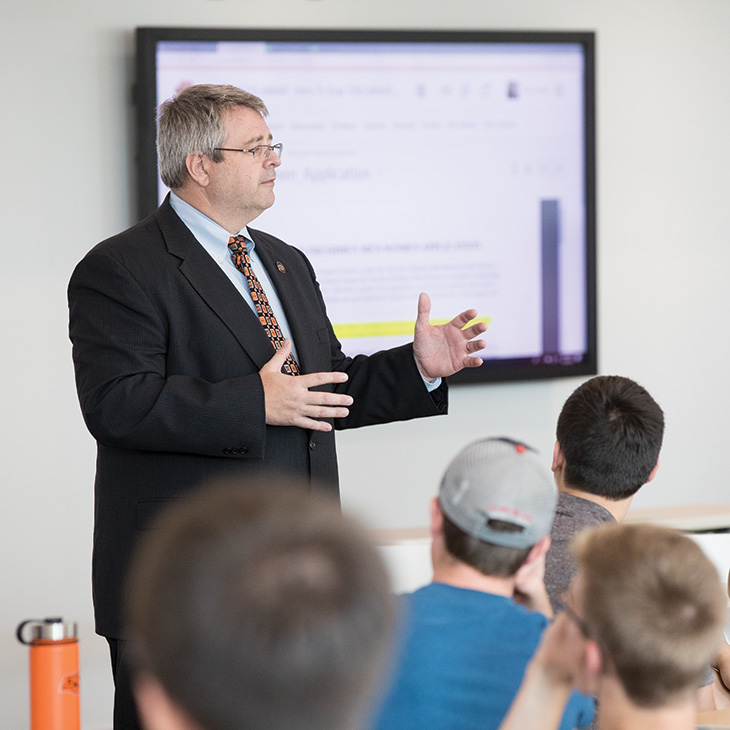
Autonomous truck corridors could transform our nation’s transportation, OSU researchers say
Friday, October 18, 2019
Two Oklahoma State University researchers have come up with a plan to rebuild America’s interstate infrastructure for the 21st century, making interstate highways safer, less crowded and longer lasting.
The two are Dr. Tyler Ley, a structural engineering professor in OSU’s School of Civil and Environmental Engineering, and Dr. Paul Tikalsky, the dean of OSU’s College of Engineering, Architecture and Technology.
Their idea is to build new roads next to existing interstates for the sole use of electric-powered, self-driving freight trucks. These autonomous truck corridors could be built to hold much more weight, allowing the autonomous trucks to travel at higher speeds, save energy by traveling closer together and provide trucking companies with a reliable way to move products. Overhead electric and fiber-optic lines would power and monitor the trucks.
Oklahoma, as part of the Midwest and southern Great Plains, would be the perfect location to start this transformation. Tikalsky, who has worked on a wide variety of transportation and infrastructure projects throughout his career, sees the heartland as the nation’s freight, energy, trade, transportation and information backbone.
The idea has made its way to the halls of the U.S. Senate, thanks to Tikalsky’s meeting with the Senate Appropriations Committee in Washington, D.C., to propose the autonomous truck corridor.
“We aren’t the only ones thinking about this, but someone has to start it,” he said. “It is time for a national effort to build cohesive and enduring infrastructure corridors that provide our nation with economic and sustainable transportation, utility and information corridors that drive commerce and security for the next century.”
The benefits of an autonomous truck corridor could include quicker, more reliable delivery times and lower greenhouse gases.

“The technology needed to make all this happen already exists,” Tikalsky said.
OSU is in a partnership with Pennsylvania State University and University of North CarolinaCharlotte to help the autonomous truck corridor become a reality. One of the group’s proposals is to create a University Transportation Center in Stillwater, where experts from private industry, government agencies and academia would work to make the autonomous truck corridor a reality.
“I have dedicated my life to improving roads and bridges,” said Dr. Tyler Ley “Our roads are in pitiful shape.”
“This corridor will require a new way of thinking in the design, operation, maintenance and financing of transportation infrastructure,” Tikalsky said. “Our team has written support from dozens of companies, four (departments of transportation) and turnpike authorities. People who think this is 10 or 20 years out could be grossly mistaken. We could build 100 to 200 miles within a few seasons.”
Trying out an autonomous truck corridor on Interstate 44 between Oklahoma City and Tulsa could show that the concept works with existing technology, he added.
Tikalsky, previously the deputy director of the Larson Transportation Institute at Penn State, was involved in a project to build a 10-mile stretch on Interstate 99 in Pennsylvania that cost the same as a traditional road but would last 100 years. It is still in great shape nearly 20 years later, he said.
“This current proposal would not have been possible without the experience of developing this (Pennsylvania) corridor,” he said. “A substantial effort of this previous work was to convince owners, designers and contractors that it is possible and practical to do something better than what they do now.”
Oklahoma took its first steps toward becoming an autonomous vehicle leader in May when Gov. Kevin Stitt signed a bill into law that gives the state control over all legislation affecting autonomous vehicles. The Oklahoma Department of Transportation is currently looking at future policies.
“This makes it even easier for the autonomous truck corridor to happen in Oklahoma,” Ley said.
Our interstate highway system dates back to the 1956 Federal Aid Highway Act, which paved the way for 41,000 miles of roadways across the country.
But now, 60-plus years later, the U.S. has aging roads and bridges that are falling prey to lower budgets and higher congestion. Ley estimated the infrastructure is receiving less than half of the funding it needs today.
“I am tired of incremental changes,” Ley said. “We need a massive, huge, game-changer approach.” Tikalsky agrees.
“When we built the interstates, it gave us a huge commercial advantage to all other countries,” he said. “How do we build this spine that allows our freight for the 21st century? If we do it, we would really be the envy of the world.”
They foresee building autonomous truck corridors in high-demand, freight traffic areas throughout the country. A single corridor spoke into a city would get the trucks to a central facility; local drivers could then complete the deliveries.
Ley envisions many of today’s 3.5 million truck drivers being able to work in their communities and sleep in their own beds, thus reducing the shortages and high turnover in the trucking industry.
The corridor could pay for itself and generate income through tolls.
“The autonomous truck corridor will generate the revenue necessary to support its own construction and maintenance, and potentially many infrastructure projects,” Tikalsky said. “This is a transformational opportunity.”
